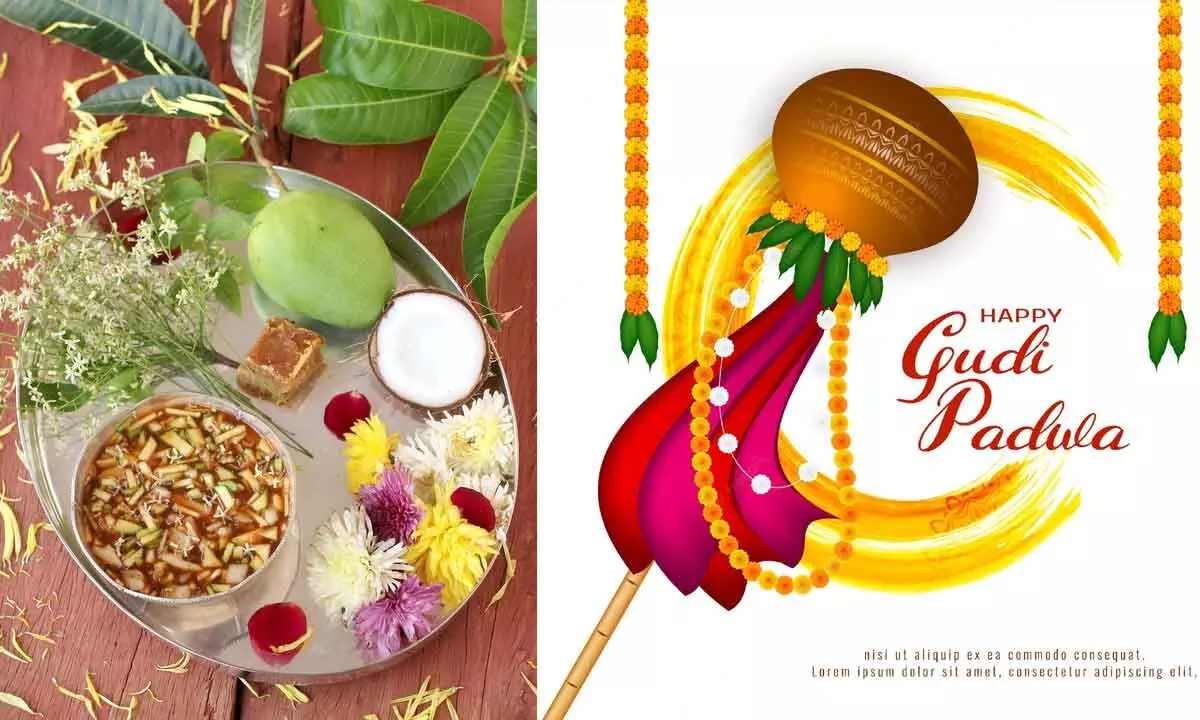Live
- BJP's Bihar leaders huddle at Union Minister Giriraj Singh's Delhi residence
- 10 Maoists gunned down in encounter with security forces in Sukma
- K’taka parties keenly await bypoll results, spotlight on high-profile Channapatna
- Hyderabad Student Aryan Reddy Dies in Tragic Gun Misfire Accident on His Birthday in Atlanta
- Iraqi PM, Putin discuss regional situation, energy cooperation over phone
- Pushpa 2 Shooting Still Pending? Will It Release on Time?
- Can air pollution affect weight gain and hormonal health?
- Vishvaraj Singh Mewar's coronation ceremony in Chittorgarh on Nov 25
- KL Rahul’s Controversial Dismissal Sparks Debate in 1st Test at Perth
- Cricket Australia to honour late Philip Hughes on 10th anniversary
Just In
Shobhakruth Promises Fresh Tidings, Fresh Harvest


Following traditions, different communities celebrate Ugadi ♦ Ugadi pachadi is an integral part of the festivities for Telugu community ♦...
Following traditions, different communities celebrate Ugadi
♦ Ugadi pachadi is an integral part of the festivities for Telugu community
♦ Kannadigas celebrate 'Yugadi' sharing 'bevu-bella'
♦ Gudi Padwa is celebrated by Maharashtrians with fervour
Ugadi heralds the beginning of everything fresh and bountiful. They include fresh tidings, fresh harvest, new season, new clothes, jewellery, so on and so forth.
As the Hindu calendar flips a new page, people usher in 'Shobhakruth Nama Samvastaram' bidding adieu to 'Shubhakruth Nama Samvastaram'.
Following traditions and culture, 'Ugadi' is celebrated in Andhra Pradesh, Telangana and Karnataka.
Even as the essence of the festival exudes charm in its own sense, there is a subtle variation in which different communities celebrate the traditional New Year, worshiping the Creator and expressing gratitude for the abundance that one is blessed with.
Ugadi signifies newness and Telugu people celebrate it with everything fresh. Apart from bringing home brand new clothes and jewellery, some venture into new businesses which they find auspicious to begin on the occasion. "Ugadi pachadi that symbolises 'shad ruchulu' (six flavours) such as teepi, chedu, karam, vagaru, pulupu and uppu is made by incorporating fresh ingredients. From jaggery to tamarind, neem flowers to raw mango, fresh ingredients get into the dish for the festivities. The flavours of the pachadi represents different phases of life, including ups and downs which are inevitable. We should accept them with grace and learn to balance every stage of life with equal ease," explains Nirmala Devi, a 64-year-old woman, who looks forward to celebrating the festival with her loved ones.
'Yugadi'
Spreading joy and good vibes, Kannadigas celebrate 'Yugadi'. Even as the community celebrates the festival with fresh tidings, ushering in abundance, traditions followed vary from place to place. While north Karnataka follows different rituals, so do south and coastal parts of the state. "Apparently, the festival symbolises growth, prosperity and abundance. The celebrations begin a few days in advance by cleaning the house and tying 'toranams' (strings of mango leaves) at the thresholds. One of the most significant parts of the festival is the traditional meal that includes 'payasam' and 'holige'. The ritual of sharing 'bevu-bella' (neem flowers and jaggery) is customary in most households," shares Vanita Vishnumurthy Bhat, an entrepreneur, with The Hans India.
Gudi Padwa
Hoisting 'gudi' (flag), Maharashtrians settled in Visakhapatnam say that they celebrate 'Gudi Padwa' according to the luni-solar Hindu calendar. For the community, 'Gudi' represents a flag decked with flowers, mango and neem leaves. "The flag will be topped with an upturned vessel and decorated with kalash, silk sari, etc. the 'kalash' signifies success, while neem leaves represent wellness. The silk sari epitomises prosperity," elaborates Charusheela Deshpande Lele, a quality assurance professional who came to Visakhapatnam 25 years back from Mumbai.
Maharashtrian families hoist the flag outside their homes representing victory or achievement as they believe that the 'Gudi' will ward off evil and usher in prosperity.

© 2024 Hyderabad Media House Limited/The Hans India. All rights reserved. Powered by hocalwire.com






